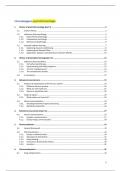Resume
Samenvatting Psychofarmacology (keuzevak fase 3) - geslaagd 1e zit
- Cours
- Psychofarmacology
- Établissement
- Thomas More Hogeschool (tmhs)
Dit is een samenvatting van het keuzevak Psychofarmacology van Toegepaste Psychologie aan Thomas More Hogeschool Antwerpen. Ik slaagde met deze samenvatting in de 1e zit (15/20). Het bevat alle hoorcolleges en is gemaakt aan de hand van de powerpointn, eigen notities van de hoorcolleges en teksten...
[Montrer plus]











